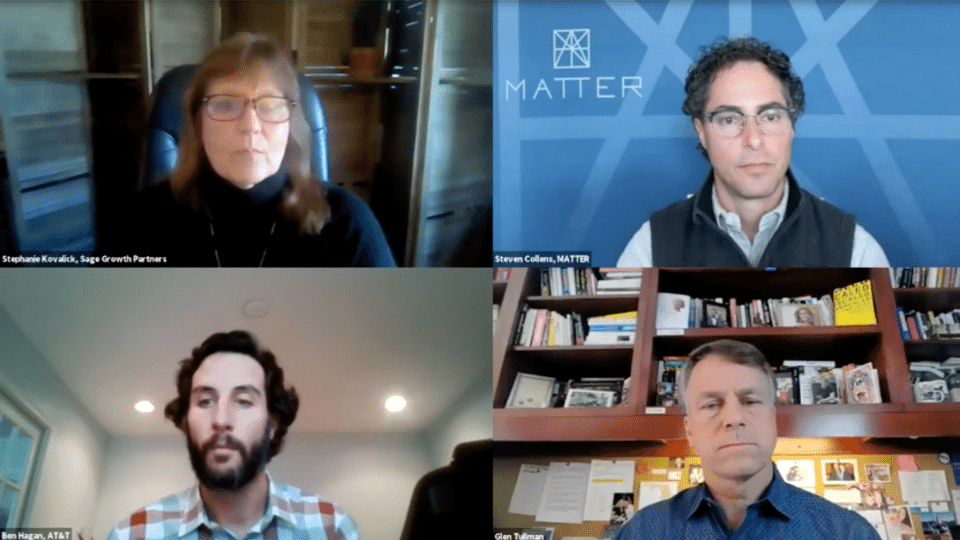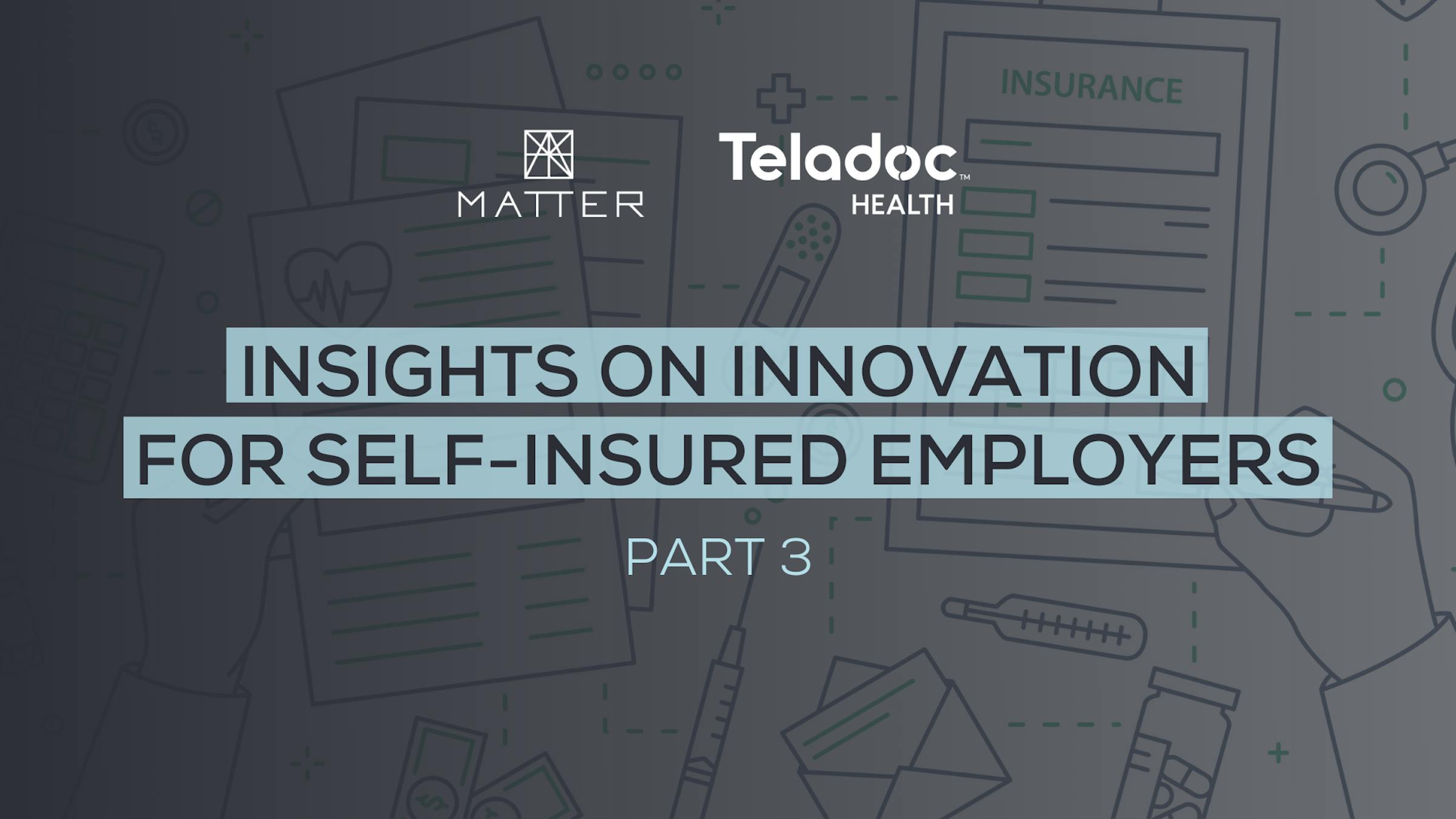Leaders from AT&T, Teladoc and Sage Growth Partners discuss how to build a whole person employee health strategy
To best serve their employees, today’s self-insured employers need a benefits solution that enables whole person care — collaboration and regular communication across all of an individual’s providers, from primary care to behavioral health, to improve health outcomes while making more effective and efficient use of resources. Employers have a wide array of options when it comes to identifying the solutions that will improve the health of their employees — but currently, most of these solutions don’t work together. To combat this, employers are tasked with building or partnering with innovators to build a single platform that helps stitch together this collection of solutions.
Our program series produced in partnership with Livongo (now a Teladoc Health company), Insights on Innovation for Self-insured Employers, is designed to help employers further advance their healthcare innovation strategies and help industry innovators understand how to best collaborate with them.
In part three of the series, MATTER CEO Steven Collens led a conversation with Glen Tullman, founder and former executive chairman of Livongo and managing partner at 7Wire Ventures, Benjamin Hagan, assistant vice president of benefits at AT&T and Stephanie Kovalick, chief strategy officer and managing partner at Sage Growth Partners about how they approach building and providing whole person strategies.

Stephanie Kovalick, Steven Collens, Benjamin Hagan and Glen Tullman discuss whole person employee health strategies at the live event on March 11
Watch the full event at matter.health/live, and read the recap of parts one and two of this series.
Following are our takeaways from two of the key questions discussed during the event. Responses have been edited slightly for length and clarity.
How has the market evolved over the last 5 years and over the next 5 years, where is the biggest traction going to come from?
Benjamin: “When we think about the various platforms we want to adopt, from a purely operational standpoint, it’s a lot easier to contract with one thing across that solves for all of the problems that exist. But the flip side is that you might not be getting a best in class solution when you do that. Prior to the last five years, the solutions companies were buying were a mile wide and a foot deep — solutions that try to take care of all the care management programs and check all the boxes. Now, a lot of us are saying, ‘Hmm, that didn’t really drive the results we wanted.’
“When we think about moving toward point solutions, trying to put a collection of solutions in a platform makes a lot of sense. And we would even take it a step further to say that our members don’t care what brand the platform is. They just want the platform to be seamless, and seamless in our ecosystem — which is different than what it means to be seamless in our competitor’s ecosystem. We’re trying to push that agnostic view where the platform we’re trying to build is different from everybody else’s, but it’s plug and play with best in class solutions.”
Glen: “In Livongo’s early days, we had a global solution that did everything, but nothing very well. Then we went to an individual solution for diabetes. Then, very quickly, we found that our members with diabetes were also looking for a tool to manage their hypertension, their weight, behavioral health issues and more. They told us that it would be great if there was one place to go to solve more than one problem in a quality way. That feedback from our members drove our expansion. To do that we actually acquired some of the best in class solutions that were already out there and available. So we started to expand and move to that whole person platform.
“If we look back at the history of other software development, it starts off with either no platform or disparate solutions that don’t work. Probably the best example is Microsoft Office. Before that, there was Lotus and Word Perfect and a handful of other solutions. Then Microsoft came along and put them together. In healthcare, we’re to a point now where people are saying, ‘Make my experience better. Make it easy for me to stay healthy and give me a platform that has to be better than what the payers traditionally provided.’ That’s the next generation of experience-focused platforms that allow you to solve your healthcare challenges in one place, while providing value — a combination of quality in clinical outcomes and cost savings.”
“In healthcare, we’re to a point now where people are saying, ‘Make my experience better. Make it easy for me to stay healthy and give me a platform that has to be better than what the payers traditionally provided.’ That’s the next generation of experience-focused platforms that allow you to solve your healthcare challenges in one place, while providing value.” - Glen Tullman
Stephanie: “In the research that we do at Sage Growth Partners, we’ve talked to a lot of benefit leaders and I found that they all fell into maybe one of two categories. In the first category, they’re very focused on costs and they say, ‘Look, our Type 2 diabetes population is costing us the most money. That’s the problem we want to solve, and we want to have a big impact on our medical costs or a pharmacy spend.’
“On the other end of the spectrum you have folks that are saying, ‘We are looking at our employee population as a whole. Yes, medical spend is important, but so are some of these other things. We want happy, healthy employees who come in to work every day.’ These folks are a little bit more innovative in how they think about their benefits. Finding the right benefits strategy is not just a way to reduce costs — it’s a way to create a larger ecosystem that solves a whole array of problems for their employees. Doing this requires identifying the pain points and following and connecting the money. So how can you illustrate that? You can solve the problem effectively for the majority of the population and deliver that ROI.”
Quality and value are measures of success for healthcare solutions. What’s the best way to measure the success of solutions and how should we define strong ROI?
Benjamin: “When we think about quality, we’re thinking about outcomes-based quality and true clinical quality — not Yelp scores. If you are truly driving quality, you might pay a little more in the short-term, and that’s okay because in the long-term, you’re going to get clinical ROI.
“When we think about ROI, some of those softer pieces like satisfaction are nice to have, but not necessarily need to have when we think about the solutions that are going to stay through a financial challenge, like the one we had in 2008. That’s why ‘hard ROI’, coupled with utilization-based pricing is key because high utilization is going to drive a lot of costs out of the system. We also want to make sure that we can prove it independently of the vendor. And to that point, it’s ensuring that all that clinical data is transferred on an individual basis back to whether it’s our data warehouse. That helps us ensure that we as the employer can have an independent view to say what is really ROI and make sure we agree on how it’s calculated.”
“If you are truly driving quality, you might pay a little more in the short-term, and that’s okay because in the long-term, you’re going to get clinical ROI.” - Benjamin Hagan
Stephanie: “Certainly there are the specific measures of quality and outcomes and measuring results of patient’s blood work, for example and ongoing clinical measures as a result of quality outcomes. I think on the more emotional side of quality, and in the interviews that we had with benefits leaders, a lot of folks we talked to mentioned when their employees would tell them how great the solution is, and that’s the soft ROI. The benefits managers feel like they’re doing something good for their employees. So if they take the time to reach out independently and say, ‘I love this solution, it’s really helped me. I’ve lost 10 pounds. My blood work is great.’ Then there’s something special there.”
Benjamin: “Stephanie hit on the key point, which is that employers don’t come to you because they like the colors or it feels good that they have this solution or that they got the brand name solution. It’s when employees see improvements in their health, which is driving hard ROI somewhere. It’s a critical point to tie together because again, the actuary in me wants to then tie it back to the hard ROI and forget the soft stuff. The soft stuff is also important because the person does feel better when they’re getting healthier and they’re getting holistic care from one source that can solve their problems in a quick amount of time.”
Who should we look to to build these solutions?
Benjamin: “The suppliers or the vendors are the ones building these solutions. We see it with Livongo and Teladoc as an example. They will be one of probably a handful who come up with solutions that serve as an off-the-shelf solution, taking the whole-person view. That will be sufficient for a certain subset of employers, but there’s also another subset — whether it’s large employers, complex employers or the intersection of the two that will have to continue to build the platform themselves.
“These employers will say, ‘We like your out-of-box solution. Now let’s put it back on the shelf and let’s partner together to build something that works best for our ecosystem and our unique needs’. At AT&T, our needs as a company are different than our competitors even though we’re essentially doing the same type of work. We’re all going at this problem at different times and from different angles. And to be honest, there’s not a singular solution or a singular platform, or a singular point solution that all of us are going to navigate towards. Once the market understands that, it creates more partners for us.”
Visit our events page to sign up for more conversations on healthcare innovation and the business of healthcare.



